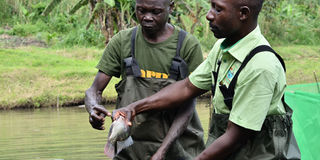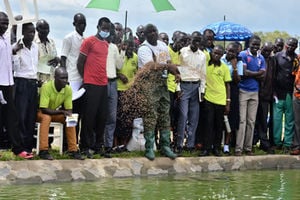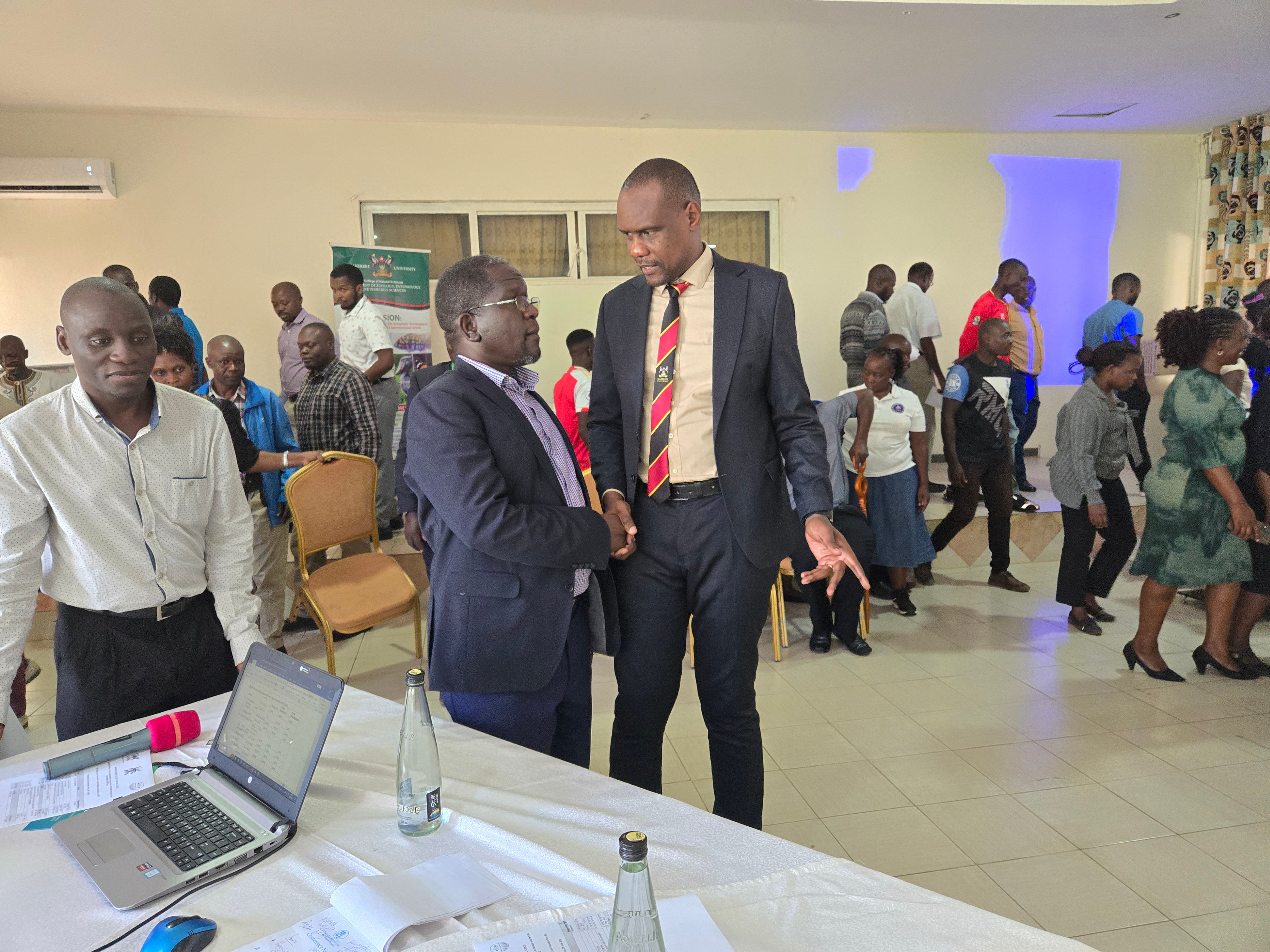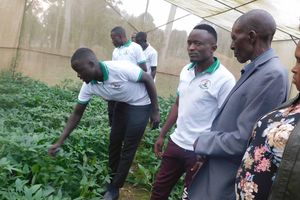
Experts at Rwebitaba Zardi demonstrating the best practices of fish farming. PHOTO/George Katongole
Fish farmers have been cautioned against the dangers of low oxygen levels and overcrowding, which can lead to significant losses in their ventures.
Howard Kasigwa, an aquaculture researcher at the Ngetta Zonal Agricultural Research and Development Institute (Ngetta ZARDI) in Lira City, emphasises the critical role of oxygen in fish survival and growth.
He says: “Oxygen is vital to fish. Inadequate oxygen levels can stress fish, reduce growth rates, and even lead to mass mortality. Factors such as high temperatures, excessive organic matter, and overcrowding can rapidly deplete oxygen levels.”
Fish thrive in water with dissolved oxygen (DO) levels above 3mg/L. Signs of low oxygen include fish gasping at the surface, even after feeding.
Kasigwa explains the importance of factors like incoming water, phytoplankton growth, and aeration for maintaining adequate oxygen levels.
Overcrowding in a fish pond occurs when there are too many fish for the available water volume. This situation creates an unhealthy environment for the fish and can lead to significant losses.
When a pond is overcrowded, the fish have insufficient space to swim and grow comfortably. This stress can weaken their immune systems, making them more susceptible to diseases. Moreover, the increased fish population produces more waste, such as ammonia and uneaten food, which contaminates the water.
As the waste accumulates, it consumes oxygen, leading to a decline in dissolved oxygen levels. This oxygen depletion can suffocate the fish, resulting in mass mortality.
Drivers
According to Kasigwa, the temptation for overstocking is a prevalent issue among Ugandan fish farmers, driven by a combination of factors. The allure of rapid growth and higher profits often tempts farmers to exceed optimal stocking densities.
Unfortunately, this practice can have dire consequences. Overcrowded fish ponds are more susceptible to diseases, experience slower growth rates, and face increased mortality due to oxygen depletion. Moreover, a lack of awareness about the negative impacts of overstocking can contribute to this problem.
“Many farmers think they will ease their economic pressures through overstocking. The desire for quick returns can lead farmers to overstock their ponds in hopes of higher yields. But this has negative consequences such as reduced growth rates, increased disease susceptibility, and oxygen depletion,” Kasigwa says.
To mitigate these challenges, farmers must prioritize education and training on sustainable aquaculture practices.
Optimum stocking density
To maintain a healthy fish population, Kasigwa explains that it’s crucial to calculate the appropriate stocking density for your pond based on its size, water quality, and the species of fish being cultured.
Determining the optimal stocking density for a fish pond is crucial for successful aquaculture.
Stocking density is mainly determined by the pond size, fish species, water quality, feeding regime and harvesting plan.
Dr Kasigwa says that different fish species have varying oxygen requirements and growth rates while the amount and type of feed provided will impact waste production and oxygen consumption.
Determining the right number of fish for your pond is crucial. Tilapia farmers should aim for a stocking density of 2 to 4 fish per square metre in low-intensity systems and 10 to15 fish per square metre in intensive systems.
For instance, if a farmer has a 100-square metre pond and plans to raise catfish in a semi-intensive system, they could stock between 500 and 1000 catfish.
“Aquaculture experts are best placed to provide tailored stocking density recommendations based on specific factors such as fish species, water quality, and desired production goals. But farmers should remember that Consistent monitoring of water quality parameters and fish health is crucial for adjusting stocking density as needed,” Kasigwa says.
Regular monitoring of water quality and fish health is crucial for adjusting stocking levels as needed.
He explains that farmers should consider having a second pond ready for when the fish population outgrows its current space to prevent overcrowding and its negative impacts.
He advises farmers to regularly monitor fish growth and transfer larger fish to the additional pond to maintain optimal conditions in both.
Interventions
Northern Uganda is experiencing a growing interest in fish farming, driven by factors such as declining fish stocks in natural water bodies and increasing demand for protein. Several initiatives have been launched to support fish farmers in the region.
The UN World Food Programme (WFP) has implemented a pilot project to empower communities through fish farming. By providing training and resources, the project aims to improve both income and nutrition. The Agricultural Business Initiative (aBi) has also supported fish farmers in the region through its UPSIDE programme, offering financial assistance and training. Government efforts are also underway to stimulate large-scale aquaculture in northern Uganda. The Fisheries State minister has outlined plans to make the region a leading fishing hub, with a focus on export markets.
As a research institute, Ngetta ZARDI serves as a crucial support system for fish farmers in the region. The institute’s commitment to research and development has led to significant advancements in aquaculture practices.
Through comprehensive training programmes, farmers gain valuable knowledge on fish breeding, nutrition, disease management, and pond management.
Furthermore, Ngetta ZARDI plays a vital role in bridging the gap between farmers and markets by facilitating linkages with buyers and processors.
The institution’s focus on capacity building empowers farmers with the skills to manage their fish farms efficiently and profitably.








